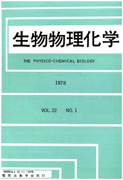All issues

Successor
Volume 22 (1978 - 197・・・
- Issue 4 Pages 261-
- Issue 3 Pages 185-
- Issue 2 Pages 117-
- Issue 1 Pages 1-
Volume 22, Issue 4
Displaying 1-6 of 6 articles from this issue
- |<
- <
- 1
- >
- >|
-
Yoshifumi Tanimoto, Gakushi Nomura, Yoshito Ueyama1979Volume 22Issue 4 Pages 261-265
Published: May 15, 1979
Released on J-STAGE: March 31, 2009
JOURNAL FREE ACCESSThe LDH isozyme patterns of human tumors transplanted in nude mice exhibited the same mobility as that of human plasma and did not change with repeated transplantation. Some of the tumorous tissues also included mouse-originated patterns. The LDH activity of the plasma of tumorbearing mice varied among the tumors, but was neither correlated with the period of transplantation nor with the activity or weight of the tomorous tissue. However when human ovarian cancer cells were transplanted, plasma LDH activity increased rapidly shortly after transplantation. In contrast, with mice bearing human Grawitz's tumors no increase in plasma LDH activity was found even 18 weeks after transplantation; at the 14th week after transplantation however, the isozyme band of human tumor origin appeared. Therefore the degree of tumor tissue proliferation may affect LDH activity in the plasma of the transplant mouse.
In these experiments, the LDH activity of several organs (the kidneys, muscles, spleen and liver) was found to either increase or decrease. It can thus be said that the changes in the isozyme patterns or activities of the plasmatic or organic LDH in mice bearing human tumors may be influenced by the specific characteristics of each transplanted tumor.View full abstractDownload PDF (3779K) -
Hiroshi Masuda, Shigeki Shichijo, Mutsuya Takeuchi1979Volume 22Issue 4 Pages 267-271
Published: May 15, 1979
Released on J-STAGE: March 31, 2009
JOURNAL FREE ACCESSGlycopeptides and a uronic acid-containing glycosaminoglycan were isolated from human cerumen and were assayed by determining the carbohydrate content of the material which remained after proteolysis.
Fractionation of nondialyzable material by DEAE cellulose column chromatography yielded five fractions. The components consisted of peptide, hexose, glucosamine, galactosamine, sialic acid and fucose; peptide and hexose were main components in each fraction. Fractions were characterized by an increase in sialic acid as the molarity of NaCl increased at the molarity of NaCl ranging from 0.01 to 0.1M. The fraction, which was eluted with 0.2M NaCl solution, contained sulfate in addition to the above constituents, and the fraction, which was eluted with 0.45M NaCl solution, contained both uronic acid and sulfate in addition to the above constituents, respectively.View full abstractDownload PDF (2094K) -
Hiroshi Masuda, Shigeki Shichijo, Toshitsugu Yamamoto, Takaaki Kurakaz ...1979Volume 22Issue 4 Pages 273-277
Published: May 15, 1979
Released on J-STAGE: March 31, 2009
JOURNAL FREE ACCESSA study has been made on the glycosaminoglycans in the human greater omentum. The uronic acid content of the greater omentum fell within the range 617-1, 285μg/g of dry tissue.
Electrophoresis on cellulose acetatate strip of concentrates of the extract in barbital buffer revealed the presence of three alcian blue-positive bands, numbered in the order of increasing electrophoretic mobility, fraction I, fraction II and fraction III; that is, fraction I corresponded in mobility to hyaluronic acid, fraction II to heparan sulfate, and fraction III to chondroitin-4-sulfate, dermatan sulfate and chondroitin-6-sulfate, respectively. The relative proportions of the fraction I, II and III were approximately 32%, 30% and 38% of thd total amount of the glycosaminoglycans, respectively.View full abstractDownload PDF (1944K) -
Nobuhiro Takahashi, Osamu Oda, Kiyotsugu Kojima, Takashi Manabe, Tsune ...1979Volume 22Issue 4 Pages 279-284
Published: May 15, 1979
Released on J-STAGE: March 31, 2009
JOURNAL FREE ACCESSA technique of immunochemical detection of plasma proteins on the slab gel after two-dimensional electrophoresis was described. The slab gel (4mm in thickness) was cut into 2 slices (2mm in thickness). One of the slices was stained with coomassie blue and the other was overlaid with antibody-containing agar layer. Bovine serum amine oxidase, as small amount as 0.5μg, could be detected by immunodiffusion followed by coomassie blue staining of the agar layer. Human myeloma IgA and human IgG were also detected by this technique. These results demonstrated the advantage of the two-dimensional technique which did not employ denaturing agent such as urea or SDS.View full abstractDownload PDF (3878K) -
II. Qualitative estimation of each bands and percentage of transferrin clearanceKiyoko Sano, Kiyoko Kanamori, Junko Yoshida, Hiroko Cho, Seijin Hosaki1979Volume 22Issue 4 Pages 285-289
Published: May 15, 1979
Released on J-STAGE: March 31, 2009
JOURNAL FREE ACCESSIt has been reported, in our previous paper, that urine proteins were fractionated into 21 bands on sodium dodecyl sulfate polyacrylamide gel. When the precipitate from antigen antibody reaction was used as a standard, proteins in 7 major bands were assumed with a fairly high probability. 21 bands were numbered from 1 to 21 from the cathode side, band 2 was α2-macroglobulin, band 9 was 2H+L chain, band 10 was transferrin, band 11 was albumin, band 13 was H chain, band 17 was L chain, and band 20 was β2-microglobulin. Six bands out of the 8 bands which may be obtained from normal urine were found to correspond to 6 bands out of the 7 bands identified. If it is assumed that each of these major bands contains a single protein, the percentage of transferrin clearance which reflects the severity of glomerulonephritis may be estimated by the present method.View full abstractDownload PDF (5275K) -
1979Volume 22Issue 4 Pages 291-319
Published: May 15, 1979
Released on J-STAGE: March 31, 2009
JOURNAL FREE ACCESSDownload PDF (2611K)
- |<
- <
- 1
- >
- >|